- Home
- slideshows
- miscellaneous
- The best baby thermometers
The best baby thermometers
The best rectal thermometer

The best forehead thermometer
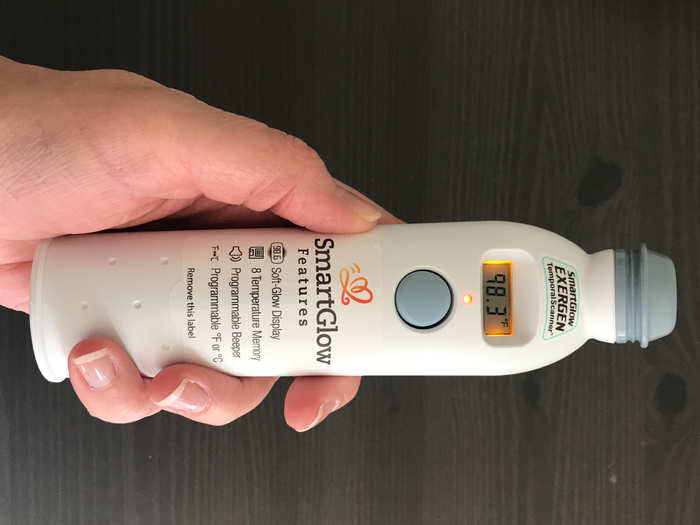
The Exergen Temporal Artery Thermometer is best for infants 3 months and older and as a backup to a rectal thermometer before then. The first thing that strikes you about the thermometer is its heft. It is ever-so-slightly heavier than other models (a good thing) and has a nice, solid wand that makes it easy to grip. The circular probe allows for better continuous forehead contact than other models with pointed and grooved tops.
This model allows for a modicum of user error if you're not completely pressed against the forehead at all times. That said, it's important to follow the directions and start in the middle of the forehead and then swipe side to side for the most accurate reading. Upon repeated testing, the Exergen delivered the most accurate and consistent readings of any model tested. However, it's worth noting that the variations for most models were very minor — typically a variation of .3 degrees.
Second to its accuracy, what I appreciate most about the Exergen is its ability to retake a temperature with no downtime in between. It makes quick work out of taking a temperature three times, something I always do at home. As a postpartum doula, I also encourage my clients to do this to ensure they are getting a consistent temporal temperature reading.
The unit is powered by an included 9V battery and automatically retains the last eight temperatures taken. It's a useful feature, though I found tabbing through the options cumbersome. There is one central button to run all commands. While it makes the unit streamlined, exiting the settings menu for silent mode and recorded temperatures proved tricky.
I appreciated the silent mode for sleeping, sick kids. And while the soft-glow display is deliberately soft, I did find it slightly dim at times, especially in light of the small display window, which is smaller than most.
Pros: Extremely accurate, consistent 3-second reading time, easy-to-grip wand, silent mode
Cons: Small and dim digital display, settings menus is not 100% intuitive, plastic packaging is cumbersome
The best ear thermometer
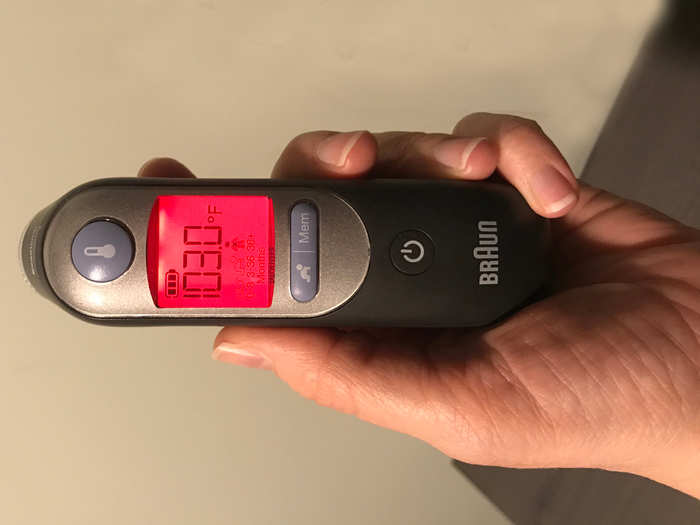
The Braun ThermoScan model is very popular among parents, providing quick and reliable readings on par with the Exergen when fever is present. Despite its age-based settings, this type of thermometer is only suitable for infants 6 months and older.
In fact, we've ranked it No. 1 in this category before. It was surprising, then, that I really didn't like it at first. I found the readings tested up to 0.5 degrees higher than other models when no fever was present. I also thought its disposable lens filters were wasteful. However — and it's a big however — when my daughter came down with a horrible case of flu, I found myself reaching for this model over and over (and the Exergen, which is, hands down, now my No. 1 choice in our home).
I felt bad for routinely checking her 103-plus degree fever with several thermometers, but I'm glad I did. The Kinsa, my early favorite, did not register fevers as accurately as it had with healthy temperatures. Braun's did. The tip was also easier to insert when she was sleeping. It's worth noting that she (and my husband) cannot stand anything in their ears and did not like the feel of this, more so than other brands. Yet accuracy reigns supreme.
Other wins: It stays true to its promise of a one-second reading, and you can take back-to-back readings. The packaging is very easy to handle, and it's ready out of the box with 2 AA batteries in place. Those pesky disposable covers? Well, I admit they're actually very helpful when rechecking high temperatures on an hourly basis.
Pros: Very accurate when fever is present, one-second reading time, age/color-coded results, sleek packaging
Cons: Expensive, not appropriate for babies under 6 months old, button to remove probe covers is overly forceful causing the covers to flip into the air
The best multipurpose thermometer
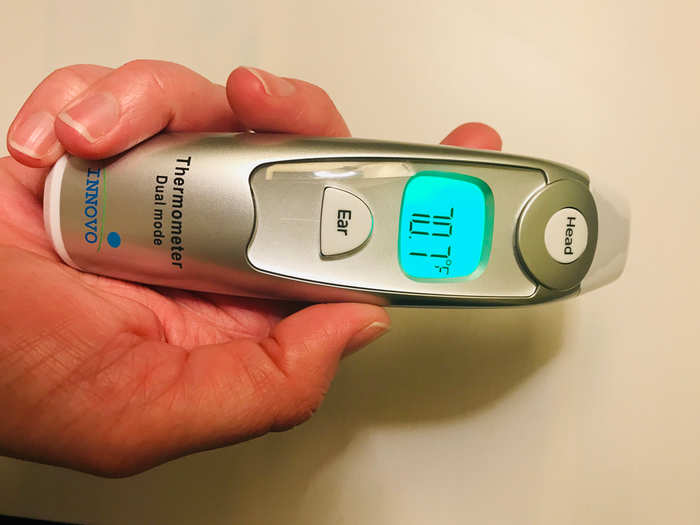
I have had my Innovo for almost four years, and it's never let me down during crucial fever moments with my daughter. For this review, I tested my own unit and then put its newest (2018) model to the test. The latest model has made some tweaks, including technology upgrades and labeling its buttons "Head" and "Ear" vs. the old "F1" and "F2".
Nine out of 10 times, the readings were just as accurate as the Exergen. While my old Innovo required a full scan of the temporal artery across the forehead, the new model can be held to the temple—I prefer this to taking a reading in the mid-forehead. Simply press the button, and it delivers a reading in one second. There is no wait time between readings.
In light of the Exergen's circular probe, the molded shape of the Innovo tip does make it slightly more difficult to get a reading in some positions — especially if you are not perfectly angled to the side of your child.
That said, the unit is light and gently curved, making it easy to hold. It makes a medium-pitch "beep" as it registers the temperature if no fever is present. If fever is present, it will beep more and flash, along with switching to red. The digital display is nicely sized, illuminated, and easy to read. The packaging is simple, and the thermometer is ready out-of-the-box with two pre-installed AAA batteries.
Given its two modalities, the shelf-life on this unit is strong, making its price tag a particular bargain.
Pros: Easy to use, accurate, a 2-for-1 bargain with ear and forehead probes
Cons: Curved tip does not connect with forehead as well as Exergen, accessing memory storage feature not intuitive
The best budget thermometer
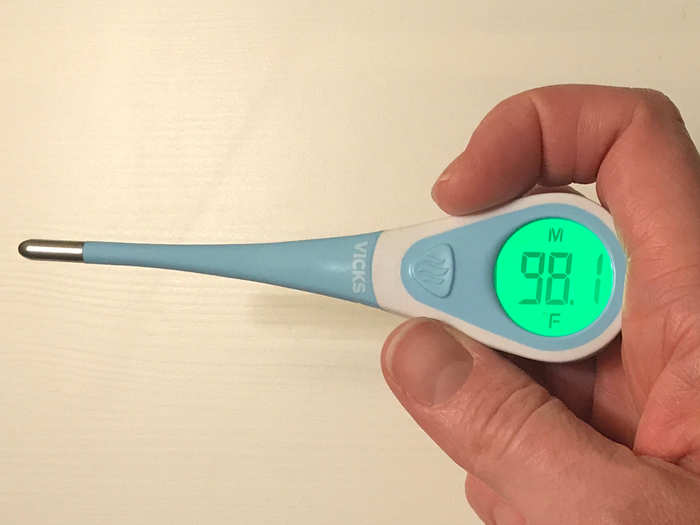
Light, slim, versatile, and very affordable, there's honestly no reason not to have the Vicks ComfortFlex in your house, whether it's your front-runner or backup thermometer.
For babies, this can be used under the arm or rectally. I believe this would be a superior choice as an oral thermometer once children are old enough to hold their breath, making it a good long-term purchase.
In testing, the ComfortFlex was very accurate and temperatures registered within 8 and 11 seconds. It has one button and performs one function, making it as basic as possible. Results are color-coded (green is normal, yellow is elevated, red is high) and easy to see on the compact circular display with large numbers.
Two drawbacks: The beep is extremely loud and you cannot take back-to-back temperatures. Users must turn the power off and on to test again, although it restarts quickly.
Packaging is relatively easy to open, and the thermometer comes ready to use with an LR44 battery installed. This thermometer is the smallest and lightest of the bunch, making it optimal for travel.
Pros: Affordable, multi-use, accurate, clear digital display, well-designed probe covers
Cons: Slow readings (by comparison) of 8 to 11 seconds, very loud beep, lag time when taking multiple readings
What else we considered
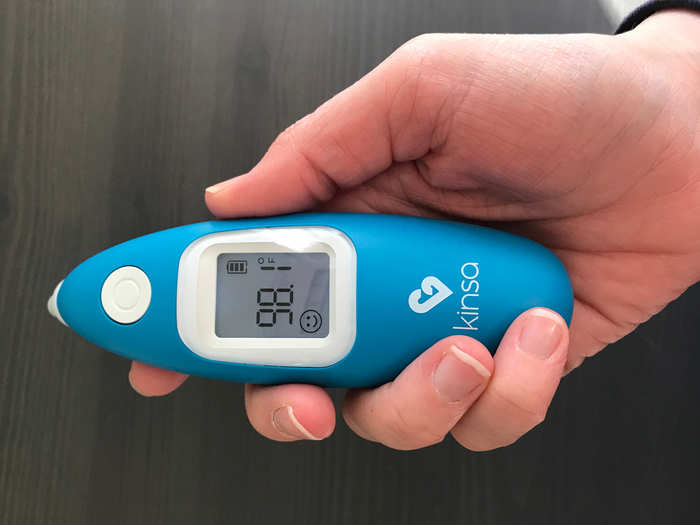
Kinsa Smart Ear Digital Thermometer ($39.99): The Kinsa is beautifully designed and the app is terrific and very helpful. Readings only take 1-second and can be done repeatedly. However, accuracy was consistently off by up to 1.5 degrees when registering fever temperatures.
Vicks SpeedRead Thermometer ($17.49): Disqualified. The unit did not function at all.
Vicks RapidRead Thermometer ($14.20): This model came neck-and-neck with Vicks' ComfortFlex for accuracy, however, it costs more than the ComfortFlex and never delivered on its 2-second promise. Readings typically took up to 5 seconds to register.
Fridababy Quick-Read Rectal Thermometer ($14.99): Although accuracy was on-point, its small, sleek design was a hindrance and made it harder to hold (and feel confident using) than Vicks' rectal thermometer.
Tempagenix Temp-N-Toss Forehead Thermometers ($8.07): Despite its convenience, these disposable, adhesive paper strips are not accurate and did not work as promised, including peeling off the forehead and taking 90 seconds to register a color.
Safety 1st Digital Ear Thermometer ($22.49): This model was accurate throughout testing and was the most comfortable to hold of all tympanic thermometers (at least for mid-size hands). However, you have to wait a full minute between tests, which is a deal-breaker compared with competing brands at this price point.
What type of thermometer should you use on your baby?
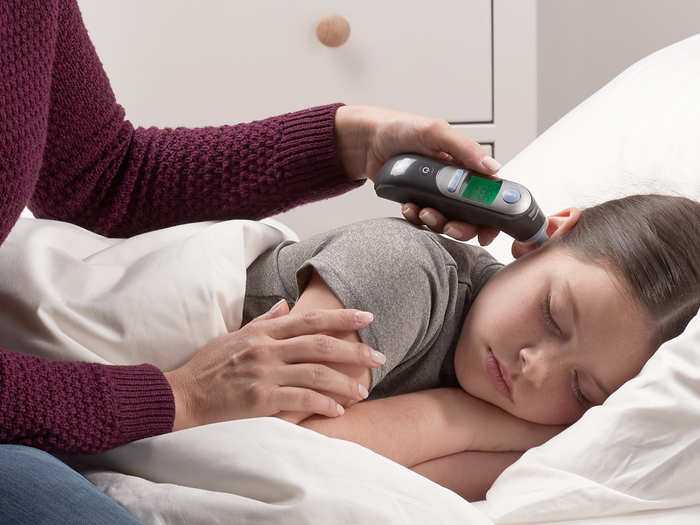
I spoke with Dr. Justin Smith, a pediatrician and the medical advisor for digital health at Cook Children's in Trophy Club, Texas, and looked at current guidelines and research to determine the most appropriate thermometers for each age group.
- Rectal (bottom): Rectal, as suggested by Dr. Smith above, is still the American standard for babies up to 3 months old. If you're afraid that you could hurt your baby with this method, take heart: The risk of rectal perforation is incredibly small (only 29 cases have been documented as of 2001, the date of the most recent study). The incidents on record are all with the use of a glass thermometer and in hospital settings, not the home.
- Temporal artery (forehead): As the popularity of temporal forehead thermometers has increased, so have the studies about its use and efficacy. They have been declared the most accurate of all noninvasive methods.
- Tympanic (ear): Tympanic thermometers are beloved for their speed and ease of use. Science isn't completely sold, however. According to most research, an ear thermometer is not as effective as a temporal one, and Dr. Smith said they're inappropriate for babies under 6 months.
- Axillary/axilla (armpit): An axillary temperature taken under the armpit is not as accurate as other methods, but it is easy and noninvasive, making it a useful "benchmark" temperature gauge. "Because you're taking a skin temperature, if the child has been bundled up or in a warm room there can be significant fluctuation," Dr. Smith said.
- Oral (mouth) and non-contact infrared (forehead): Oral thermometers should only be used on children 4 years and older who are capable of holding their breath. Early studies on non-contact infrared thermometers (NCIT) are showing they have a lot of promise, especially in the NICU, yet nothing is definitive. "They are becoming popular, and more parents are asking about them, but I think it's too early," Dr. Smith said.
The one thing everyone agrees on? A rectal or temporal artery temperature of 100.4 degrees or higher in a newborn to 3-month-old is not okay. Call your healthcare provider immediately and seek care.
How to accurately take a baby's temperature
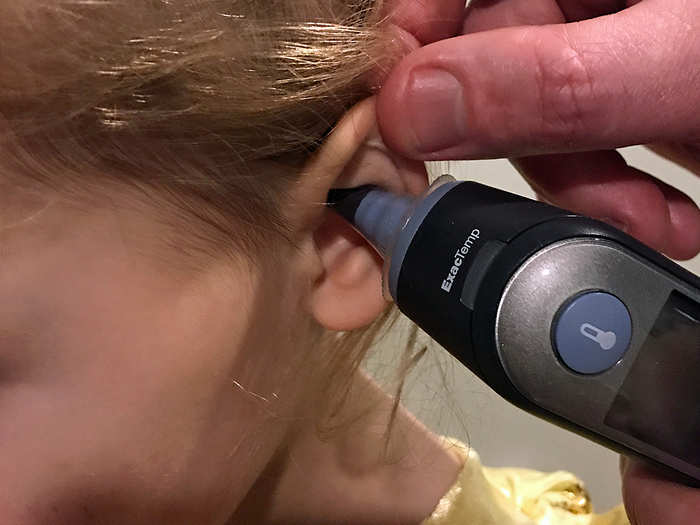
Fever accounts for 70% of all consultations with pediatricians and family physicians. Your baby's temperature can be the difference between "home care" and "urgent care," so accuracy matters. Here's how to get it right.
How to take an accurate rectal temperature- Clean the thermometer with soap and water.
- Place a small amount of petroleum jelly on the end.
- Place your baby across your lap face down or on their back on a firm surface.
- Gently place the thermometer about a half-inch into the anus.
- Place your entire hand around the child's bottom, holding the thermometer in place between your fingers.
- Hold in place for about one minute or until you hear the beep.
Tip: If you're still wondering how to master this technique, the American Academy of Pediatrics has a useful illustrated guide.
How to take an accurate ear temperature- Clean the probe before/after each use.
- Gently pull on the top outermost part of the ear (this is key).
- Slowly insert the probe into the ear canal. Do not push.
- Press the button to take the temperature.
- Remove the thermometer after it beeps.
Tip: Check for earwax buildup before use, and do not use immediately after bathing.
How to take an accurate forehead temperature- Place the probe in the middle of the forehead.
- Press the scan button and begin to move slowly to one side.
- Move from one ear, over the forehead, and toward the opposite ear.
- Release the scan button and remove the thermometer as it beeps.
Tip: It is important to maintain contact with the forehead at all times. The side-to-side motion should take between three and five seconds.
How to take an accurate temperature under the arm- Turn on the thermometer and place the probe in the center of your baby's armpit.
- Hold it in place until you hear a beep.
Tip: Ensure the thermometer is touching skin only, not clothing.
Check out our guides to the best baby gear
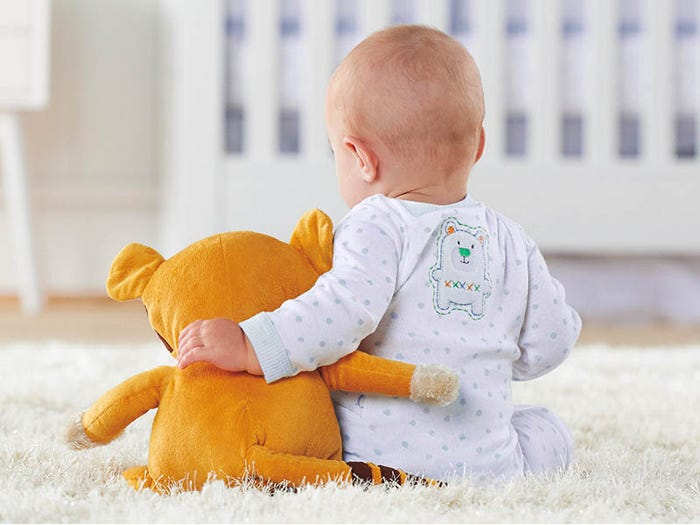
Swaddling — wrapping your baby snugly in breathable material to mimic a womb-like sensation — is the key to a good night's sleep. Your baby, when wrapped, relaxes and falls asleep. Or at least, that's the theory. These are the best baby swaddles to help them — and you — get a good night's sleep.
The best bottle warmersYou might think a baby bottle warmer is something extra that's not necessary. But when your little one is screaming in the middle of the night for warm milk, having a warmer will save your sanity, and hopefully, some sleep. These gadgets can heat formula and breast milk without hot spots so you don't have to boil water in a pan. These are the best bottle warmers.
The best cloth diapersCloth diapers are easy to use, offer money-savings, and are nothing like the ones your grandma used to use. When you get down to finding the perfect cloth diaper, it comes down to four factors: cost, sustainability, absorbency, and cuteness (your baby has to look good, after all). These are the best cloth diapers.
The best breast pumpsWhether you're running an errand, taking a short trip or heading back to work full-time, you'll need a good breast pump to get you through those times when you can't breastfeed your baby directly. These are the best breast pumps.
The best baby monitorsWhen it comes to baby monitors, parents are spoiled for choice nowadays, thanks to the rise of the connected home and new technologies like live-streaming video and high-resolution cameras. No matter which type of baby monitor you buy — whether it be an old-school audio-only monitor or a fancy Wi-Fi monitor with streaming video —these are the best baby monitors.
Popular Right Now
Popular Keywords
Advertisement